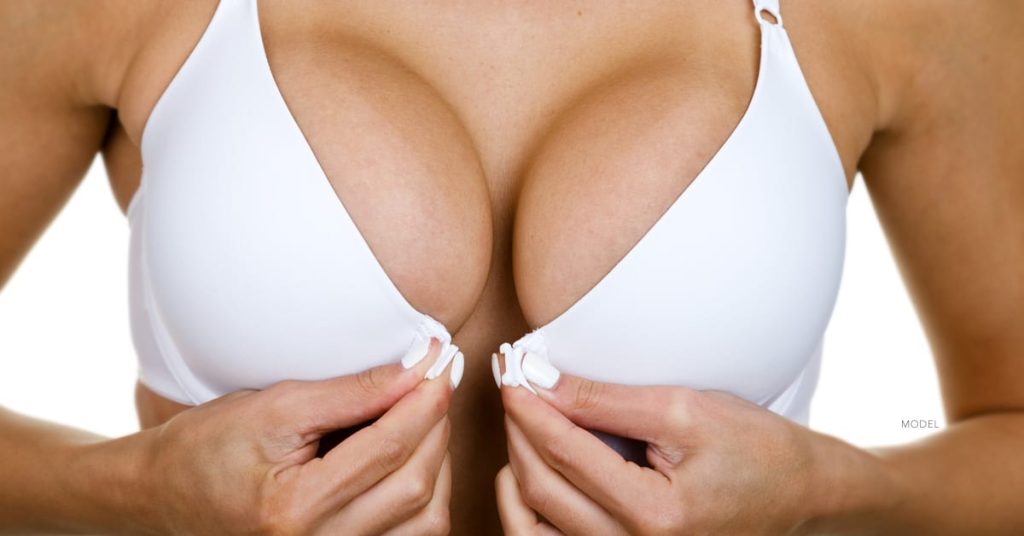Most of the women thinking about getting breast implants at our Fort Worth, TX, practice arrive at their consultations well-versed in many of the procedure’s details. They’ve researched online and may have discussed their options with friends or family members who already have breast implants.
Unfortunately, not everything you read on the web is accurate, and the friend who said you should get 400 cc, low-profile implants because that’s what she has—and she loves her results—may have a completely different body type than you. Choosing breast implants is both exciting and a bit nerve-wracking because it’s a significant decision.
That’s one of the reasons for choosing a plastic surgeon who is not only experienced and qualified but also someone you trust. One of my jobs is to provide my patients with all the information they need to feel confident in their choice of implants. This guide to breast implants provides some fundamental information that will help you make a final choice when that time comes.
Implant Size & Profile
Breast augmentation patients often say they want their breasts to be a certain bra cup size. While that can be useful information to help a plastic surgeon understand a patient’s goals, it’s important to understand that breast implant sizes don’t correspond to bra cup sizes; the size and shape of the woman’s chest determine the actual cup size.
Implant size is measured in cubic centimeters, such as 300 cc. This is a standard unit of measurement, unlike cup sizes that can vary from one brand to the other. The other consideration when choosing implants is the profile. This can be a more difficult concept to grasp than size, but it significantly affects the final results because it determines the projection of the breasts. Projection refers to the side profile or the distance that the implant projects from your body.
Together, the volume (cc) and the degree of projection you and your surgeon select will depend on your body type and the shape and fullness you want. This patient with a thin frame shows how the 2 concepts work together. (Keep in mind that the implants have yet to settle.)
https://www.instagram.com/p/CC7ZzekD0eU/
Types of Breast Implants
Virtually any woman who’s looked into the possibility of getting breast augmentation is aware that implants can be either filled with saline or silicone. Still, there’s a bit more nuance to the choices—especially regarding silicone implants.
Saline implants: About 10 years ago, most breast augmentation patients chose saline implants. That is no longer the case, as nearly 90 percent of U.S. patients now opt for silicone gel implants compared to saline breast implants. Implants filled with saline tend to feel less like natural breast tissue than silicone gel, and they have a greater chance of visible rippling. Unlike silicone gel implants that come pre-filled, saline implants are filled by surgeons after being inserted. This gives the surgeon the opportunity to fine-tune the size.
Cohesive silicone gel implants: Advances in the science behind the composition of silicone gel used in breast implants enable surgeons to customize breast augmentation surgery more than ever before. The cohesiveness of the silicone gel used in implants varies in its thickness and how much it holds its shape. This influences the look and feel of the implant after surgery, and the patient’s preference determines the choice. For example, some women want squishier implants than others.
What Does ‘Gummy’ Mean?
Our practice uses Allergan breast implants almost exclusively, a brand that includes Natrelle round “gummy bear” implants. Gummy silicone gel breast implants maintain their shape when held in the hand, even if they are cut in half—much like gummy bear candy. Even among gummy implants, some are more cohesive than others. All the implants are soft, but patients can feel how squishy each implant is by holding them.
Smooth vs. Textured Breast Implants
We use smooth, round implants for breast augmentation, and patients are more than satisfied with the outcomes. Shaped implants are generally textured to help prevent them from rotating inside the implant capsule. Some textured implants (which we do not offer) have been linked to a rare form of lymphoma, called Breast Implant-Associated Anaplastic Large Cell Lymphoma (BIA-ALCL).
You can see more before-and-after photos in our gallery of breast augmentation patients. Women travel from throughout Texas, including Abilene, to get breast augmentation surgery at our practice. You can contact us using the online form to request a consultation (either in person or virtually) or call us at (817) 228-4315 to schedule an appointment.


Leave a Reply